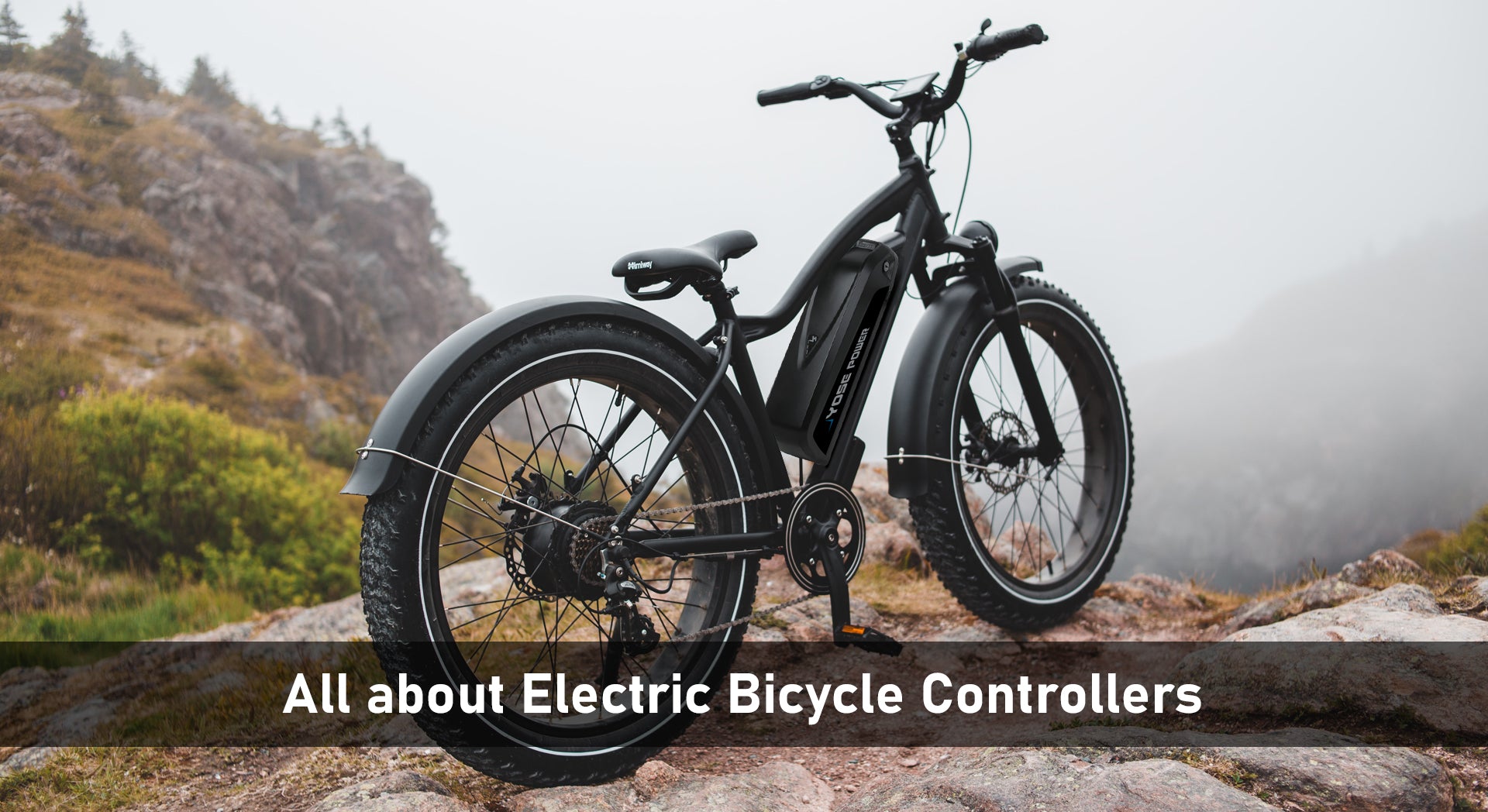Les vélos électriques, également appelés e-bikes, ont gagné en popularité ces dernières années en tant que mode de transport durable et efficace. L'intégration de technologies avancées a considérablement amélioré les performances et la fonctionnalité de ces véhicules respectueux de l'environnement. Au cœur d'un vélo électrique se trouve son contrôleur, un composant crucial qui régit son fonctionnement et offre une expérience de conduite fluide. Dans cet article, nous allons nous plonger dans le fonctionnement interne d'un contrôleur de vélo électrique, en explorant ses fonctions, ses modes de fonctionnement, ses caractéristiques de sécurité, ses conseils d'entretien et ses développements futurs.
Les vélos électriques combinent la commodité des vélos traditionnels avec la puissance et l'efficacité des moteurs électriques. Le contrôleur joue un rôle essentiel pour assurer une conduite fluide et contrôlée. Il agit comme le système nerveux central, recevant des signaux provenant de diverses entrées et transmettant des commandes au moteur, régulant ainsi la vitesse et la puissance de sortie.
Composants d' un vélo électrique
Pour comprendre le rôle du contrôleur, décrivons brièvement les principaux composants d'un vélo électrique. Le moteur est responsable de la génération de la puissance mécanique nécessaire à la propulsion, tandis que la batterie sert de source d'énergie. Le contrôleur agit comme l'intermédiaire entre ces composants, coordonnant leur fonctionnement pour offrir une expérience de conduite optimale.
Comprendre le contrôleur de vélo électrique
Le contrôleur de vélo électrique remplit plusieurs fonctions essentielles. Tout d'abord, il interprète les entrées de l'utilisateur, telles que les commandes d'accélérateur ou les signaux d'assistance au pédalage, et les traduit en instructions appropriées pour le moteur. Ensuite, il régule la puissance de sortie en fonction de la vitesse souhaitée ou du niveau d'assistance sélectionné par le cycliste. En outre, le contrôleur surveille divers paramètres, garantissant que le système fonctionne dans des limites de sécurité et fournissant un retour d'information essentiel à l'utilisateur.
Il existe différents types de contrôleurs disponibles, allant des simples interrupteurs marche/arrêt aux modèles plus avancés dotés de fonctions programmables. Le choix du contrôleur dépend des exigences spécifiques du vélo électrique et des fonctionnalités souhaitées.
Comment fonctionne le contrôleur ?
Le contrôleur fonctionne grâce à une série d'étapes de traitement du signal et de communication. Lorsque le cycliste saisit une commande, comme tourner la poignée d'accélérateur ou pédaler, le contrôleur détecte ces signaux et les traite en conséquence. Il communique ensuite avec le moteur, lui demandant de fournir le niveau d'assistance ou de puissance souhaité.
Pour réguler la puissance de sortie et le contrôle du moteur, le contrôleur utilise diverses techniques. Il ajuste le courant circulant de la batterie vers le moteur, contrôlant ainsi la vitesse et l'accélération. Le contrôleur utilise également des mécanismes de détection pour surveiller la vitesse de rotation, la température et d'autres paramètres, ce qui lui permet d'effectuer des ajustements en temps réel pour des performances optimales.
Modes de fonctionnement du contrôleur
Le contrôleur de vélo électrique offre différents modes de fonctionnement pour répondre à diverses préférences et conditions de conduite.
- Mode d'assistance au pédalage
En mode d'assistance au pédalage, le contrôleur détecte le mouvement de pédalage du cycliste et fournit une assistance proportionnelle en fonction du niveau d'assistance sélectionné. Le contrôleur mesure la vitesse et la force appliquées aux pédales, ajustant instantanément la puissance de sortie en fonction de la sollicitation du cycliste. Ce mode offre une expérience de conduite plus naturelle et intuitive, améliorant l'efficacité et prolongeant l'autonomie de la batterie.
- Mode accélérateur
Le mode accélérateur permet au cycliste de contrôler la vitesse et la puissance de sortie uniquement via une manette des gaz manuelle. En tournant ou en appuyant sur la manette des gaz, le cycliste peut accélérer ou décélérer le vélo électrique sans avoir besoin de pédaler. Ce mode est particulièrement utile dans les situations où le cycliste a besoin d'une puissance instantanée, comme lors des montées ou lors du démarrage à partir d'une position stationnaire.
- Mode combiné
Certains contrôleurs de vélo électrique proposent un mode combiné qui permet aux cyclistes de passer en toute transparence du mode assistance au pédalage au mode accélérateur. Cette polyvalence s'adapte à différents scénarios de conduite et préférences individuelles, offrant la possibilité de passer du pédalage au moteur pour la propulsion.
Caractéristiques de sécurité et considérations
La sécurité est une préoccupation majeure dans la conception des vélos électriques, et le contrôleur joue un rôle crucial pour garantir la sécurité du cycliste. Les contrôleurs modernes intègrent diverses fonctionnalités et considérations de sécurité.
- Protection contre les surintensités
Pour éviter d'endommager le moteur et le contrôleur, une protection contre les surintensités est mise en œuvre. Le contrôleur surveille le flux de courant et intervient s'il dépasse un seuil de sécurité, réduisant ainsi le risque de surchauffe ou de défaillance des composants. Cette fonction améliore la longévité et la fiabilité du système de vélo électrique.
- Surveillance de la température
Les contrôleurs incluent souvent des capteurs de température qui surveillent la chaleur générée pendant le fonctionnement. Si la température atteint un niveau critique, le contrôleur peut automatiquement réduire la puissance de sortie ou lancer des mécanismes de gestion thermique, tels que l'activation du ventilateur ou la coupure du moteur. La surveillance de la température protège le système contre la surchauffe et le protège contre les dangers potentiels.
- Coupure de frein et freinage régénératif
Pour améliorer la sécurité et l'efficacité énergétique, certains contrôleurs sont équipés d'une fonction de coupure des freins. Lorsque le pilote applique les freins, le contrôleur interrompt la transmission de puissance au moteur, garantissant une réponse immédiate et facilitant un freinage efficace. De plus, les contrôleurs avancés peuvent intégrer le freinage régénératif, qui convertit l'énergie cinétique générée pendant le freinage en énergie électrique, rechargeant ensuite la batterie et augmentant l'efficacité globale.
Facteurs affectant les performances du contrôleur
Plusieurs facteurs peuvent influencer les performances d’un contrôleur de vélo électrique, notamment :
- Tension et courant de la batterie
La tension et le courant fournis par la batterie ont un impact direct sur la puissance de sortie du contrôleur. Des tensions plus élevées entraînent généralement une plus grande vitesse et des capacités d'accélération plus importantes. De même, les batteries avec des valeurs nominales de courant plus élevées peuvent fournir plus de puissance au moteur, améliorant ainsi les performances globales. Il est essentiel de sélectionner un contrôleur compatible avec les spécifications de la batterie pour garantir une efficacité optimale.
- Caractéristiques du moteur et puissance de sortie
Les différents moteurs de vélo électrique ont des puissances de sortie et des caractéristiques de fonctionnement différentes. Le contrôleur doit être adapté aux spécifications du moteur pour garantir une distribution de puissance efficace et un fonctionnement fluide. Les contrôleurs conçus pour des types de moteurs spécifiques peuvent maximiser les performances et prolonger la durée de vie du moteur et du contrôleur.
- Paramètres et préférences de l'utilisateur
Les contrôleurs de vélo électrique proposent souvent des réglages programmables qui permettent aux cyclistes de personnaliser des paramètres tels que les niveaux d'assistance, les limites de vitesse maximales et les profils d'accélération. Ces réglages permettent aux cyclistes d'adapter le comportement du vélo électrique à leurs préférences spécifiques, optimisant ainsi l'expérience de conduite et répondant aux exigences individuelles.
Conseils de maintenance et de dépannage
Un entretien approprié et un dépannage périodique peuvent contribuer à garantir des performances et une longévité optimales du contrôleur de vélo électrique. Tenez compte des conseils suivants :
- Inspections et nettoyages réguliers
Inspectez régulièrement le contrôleur pour détecter tout signe de dommage, de connexion desserrée ou d'infiltration d'eau. Nettoyez le contrôleur à l'aide d'un chiffon doux et sec et assurez-vous qu'il est exempt de débris ou de contaminants susceptibles d'affecter son fonctionnement.
- Mises à jour du firmware et étalonnage du logiciel
Les fabricants publient souvent des mises à jour du micrologiciel pour les contrôleurs de vélo électrique afin d'améliorer les fonctionnalités, de corriger les bugs et d'introduire de nouvelles fonctionnalités. Tenez-vous informé des mises à jour du micrologiciel et mettez à jour périodiquement le logiciel du contrôleur comme recommandé par le fabricant. De plus, certains contrôleurs peuvent proposer des options d'étalonnage pour affiner les performances du système. Suivez les instructions du fabricant pour étalonner le contrôleur afin de garantir un fonctionnement précis et fiable.
- Problèmes courants et étapes de dépannage
Si vous rencontrez des problèmes avec le contrôleur de vélo électrique, voici quelques problèmes courants et étapes de dépannage :
- Pas d'alimentation ou de réponse : vérifiez la charge de la batterie et assurez-vous qu'elle est correctement connectée. Inspectez les connexions du contrôleur pour détecter tout fil desserré ou endommagé. Si le problème persiste, consultez un technicien qualifié pour un diagnostic plus approfondi.
- Puissance de sortie irrégulière : vérifiez que le capteur d'accélérateur ou d'assistance au pédalage ne présente aucune obstruction ou aucun dommage. Assurez-vous que les capteurs sont correctement positionnés et calibrés. Si le problème persiste, le contrôleur peut nécessiter un réglage ou un remplacement.
- Surchauffe : si le contrôleur devient excessivement chaud pendant le fonctionnement, vérifiez qu'il n'y a pas de blocages limitant la circulation d'air autour du contrôleur. Assurez-vous que le moteur et la batterie fonctionnent dans les limites des paramètres spécifiés. Si le problème de surchauffe persiste, consultez un professionnel pour une inspection et des solutions possibles.
- Codes d'erreur ou indicateurs de panne : de nombreux contrôleurs disposent de systèmes de codes d'erreur ou d'indicateurs de panne intégrés pour diagnostiquer les problèmes. Reportez-vous au manuel d'utilisation du contrôleur ou contactez le service client du fabricant pour obtenir des conseils sur le dépannage de codes d'erreur spécifiques.
N'oubliez pas que si vous n'êtes pas sûr de vos capacités de dépannage, il est toujours recommandé de demander l'aide d'un technicien de vélo électrique qualifié ou de l'équipe d'assistance du fabricant.
Développements futurs dans les contrôleurs de vélos électriques
À mesure que la technologie des vélos électriques continue de progresser, nous pouvons nous attendre à de nouveaux développements dans la conception et les fonctionnalités des contrôleurs. Parmi les développements futurs potentiels, citons :
- Algorithmes de contrôle avancés
Les progrès réalisés dans les algorithmes de contrôle permettent d'optimiser la distribution de puissance, d'améliorer l'efficacité et d'améliorer l'expérience de conduite globale. Les algorithmes intelligents peuvent s'adapter à divers terrains, aux interventions du cycliste et aux conditions environnementales pour fournir des niveaux d'assistance optimisés et un contrôle moteur plus fluide.
- Intégration avec les technologies intelligentes
L'intégration des contrôleurs de vélo électrique aux technologies intelligentes ouvre de nouvelles possibilités. Des fonctionnalités telles que la navigation GPS, la connectivité des smartphones et la communication sans fil peuvent améliorer le suivi des trajets, fournir un retour d'informations en temps réel et permettre une intégration transparente avec les appareils et applications intelligents.
- Efficacité et performances améliorées
Les futurs contrôleurs de vélos électriques pourraient intégrer des techniques avancées de gestion de l'énergie, des systèmes de freinage régénératif et des solutions de stockage d'énergie pour maximiser l'efficacité et prolonger l'autonomie de la batterie. Ces développements visent à optimiser l'utilisation de l'énergie et à offrir des trajets plus longs et plus durables.
Conclusion
Le contrôleur d'un vélo électrique est un composant essentiel qui régit son fonctionnement, offrant contrôle, sécurité et une expérience de conduite fluide. Comprendre le fonctionnement du contrôleur, ses différents modes de fonctionnement, ses fonctions de sécurité et ses exigences de maintenance est essentiel pour les passionnés et les cyclistes de vélos électriques. En restant informés des dernières avancées et en suivant les pratiques de maintenance appropriées, les cyclistes peuvent profiter des avantages des vélos électriques tout en garantissant des performances et une longévité optimales du système de contrôle.
Apprenez-en plus sur les vélos électriques sur NEWS .
Utilisez le code de réduction YOSELILY pour bénéficier de 10€ de réduction sur votre achat de vélo électrique.


Partager:
Conseils pour faire du vélo en été
Comment fonctionne le moteur d'un vélo électrique ?